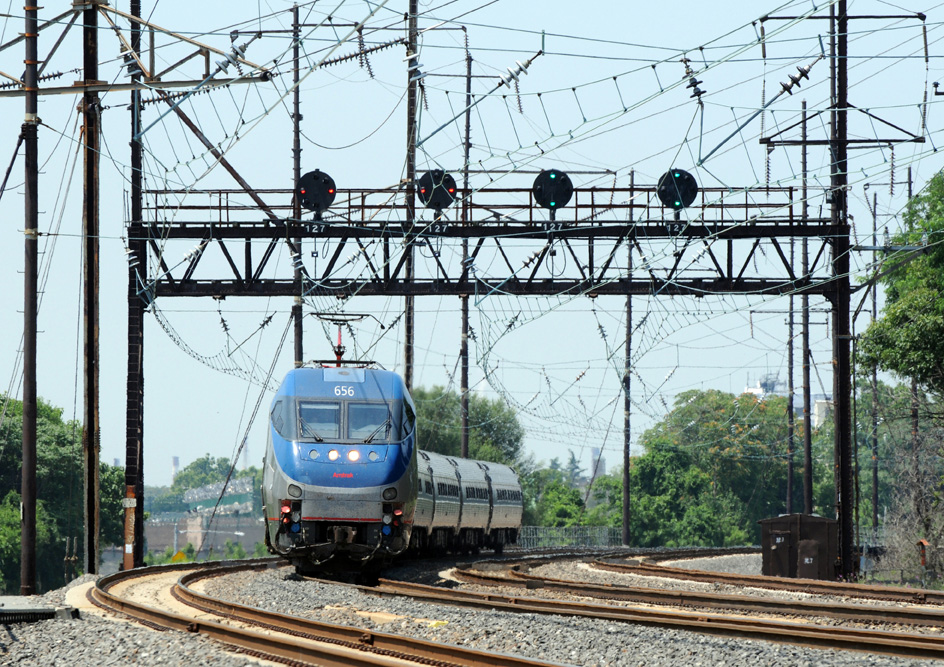Editor's note: this article is part one of an ongoing series on the new book, "Cars and Jails." Read parts two and three here.
For more than a century, America's car-dependent transportation system has silently barred millions of U.S. residents from social, economic, and non-automotive mobility, all while manipulating them into believing that they have more freedom to move than ever before. For some, though, the consequences of car dependency have landed them behind literal bars — and in more ways than even the most avowed sustainable transportation advocates might realize.
For their groundbreaking and essential new book Cars and Jails, New York University professors Julie Livingston and Andrew Ross worked with a team of formerly incarcerated peer researchers to examine what they call "the continuum between auto ownership and incarceration" in the United States. The book, though, could just as easily be called "Cars, Jails, and Money" for how inextricable our criminal justice systems are with our systems of consumer debt, corporate profit, and mass surveillance — and how impossible it will be to unravel one without confronting the others.
"Operating a car basically holds us in social and economic custody," said Ross. "And the carceral system extends far beyond prisons and jails."
In this series, we'll look at three portals to incarceration outlined in their book, starting with the humble dealership.
'You can't really choose not to have a car'
For the average American, a lifetime of car dependency often begins at the auto lender's desk. A whopping 87 percent of new cars and a significant 34.5 percent of used cars are bought with loaned money, bringing our national auto debt total up to $1.56 trillion in the first quarter of 2023.
That staggering number isn't always viewed as a widespread crisis, Livingston and Ross argue — even as other debt economies spawn anxious headlines and win billions in public relief for borrowers.
During the early days of the pandemic, for instance, federal moratoriums on student loan obligations, mortgage payments, and rental evictions all offered respite to struggling Americans, but car loans were still due in full — and once the other bills started arriving again, "the volume of subprime borrowers with car loans more than 60 days overdue saw straight monthly gains," the authors write.
In the vast majority of car-dependent American cities, automotive debt is simply the price many we must pay for basic mobility — and often, we'll have to keep paying it for the rest of our lives as our cars inevitably wear out.
“We know student debt is a huge problem that’s been in the news a lot; there are all sorts of very good reasons to abolish it. There hasn't been the same hullabaloo about auto debt," added Ross.
"You can choose not to go to college. You can choose not to buy a home and have mortgage. But for the most part, you really can't choose not to have a car in America ... When people are vulnerable in that way, the worst things can happen.”
'The prototype for debt-driven extraction'
Part of the reason why many Americans aren't outraged over their collective automotive debt burden, the authors argue, is because they don't realize just how bad things are — or the extent to which deeply extractive lending is rooted in automakers' core business model. Way back in the 1930s, Livingston and Ross say, executives at General Motors realized that their financing arm was actually more profitable than its famous assembly lines, and began to reconceptualize their core product as a delivery mechanism for debt.
“Cars were the prototypes for debt-driven extraction long before the age of financialization," they write in Cars and Jails. "Though its initial goal was simply to move more product more swiftly, the firm soon found the financing to be a more lucrative business than the selling of cars themselves. These profits were magnified by 'planned obsolescence,' GM’s other innovation in capitalist salesmanship.”
That's particularly true for the roughly one-fifth of borrowers who are forced to accept loans at sub-prime rates because they have bad credit. While new and used car loans average about 6.57 and 11.17 percent in annual interest, respectively — student loans, for contrast, ballpark at 5.8 percent, and 82 percent of homeowners have mortgages under five percent — deep subprime borrowers typically pay about twice those rates, and sometimes far more.
In states like Colorado and Oklahoma, for instance, carveouts in usury laws actually allow lenders to charge as much as 45 percent on car loans, while others, like Nevada and New Hampshire, have no interest caps at all. Some dealers have admitted to charging as much as 300 percent to their riskiest borrowers — a rate more commonly seen among predatory payday loan outfits.
Even in states with comparatively strong borrower protections, like New York, dealer often sidestep lending regulations by signing customers up for something called “retail installment sales contracts” instead of traditional loans, committing them to a fixed number of payments over time — plus a steep finance charge that far exceeds the legal caps on extractive lending. Between steep interest opportunities and all the profit to be made from selling "auto asset backed securities," or bundles of subprime loans, one auto lending giant didn't even bother to verify the income of 97 percent of its borrowers.
Aside from the core car loan, auto retailers often saddle buyers with a mountain of additional debt for supplementary services, which often make up the majority of their actual profit margins. Livingston and Ross note that "buyers with tarnished credit scores — almost guaranteed for anyone with a recent criminal record — are especially at risk of ending up…with signed paperwork that is packed with made-up fees and add-ons," including "extended warranties, gap insurance, window etching, roadside assistance, service contracts, rustproofing, and protection packages for everything including keys, tires, wheels, paint, and fabric."
On top of all that, dealers often refuse to sell subprime borrowers the small, inexpensive cars they can actually want, steering them instead towards large, luxury models on which they can make a higher profit. One of the Cars and Jails peer researchers, for instance, said he tried to buy a modest Honda after he was released from jail, but ended up with a BMW because it was the only vehicle for which the lender would offer him a loan; his monthly insurance and loan payments alone totaled $1,300. Another one of the researchers wanted to buy a modest pick-up, but ended up with a much larger and more expensive model that he didn't want (and which, it should be noted, would be far more lethal to any pedestrian he might hit).
Perhaps unsurprisingly, the authors say all of these debt mechanisms disproportionately affect Black and brown borrowers, particularly if they were formerly incarcerated.
“Ironically, we found that many people newly released from prison could end up driving the status car of their dreams precisely because their subprime credit score puts them at the mercy of rapacious lenders,” the authors write.
And in the meantime, their neighbors will likely judge them for buying a flashy car they can't afford — even if they don't have another option.
"The pleasure and status associated with cars keeps them classed as a luxury in the popular imagination, and there is little moral outrage about how and why driving a car has become such a tightly sprung debt trap, unevenly afflicting lower-income and minority drivers," they write.
'A losing proposition'
It would be one thing, of course, if auto loans caused temporary financial pain for borrowers, but still left them with a useful and re-sellable asset once their balance had been paid — and to be sure, some of them do. Livingston and Ross say, though, that isn't always the way the story ends, even for borrowers who aren't forced to accept sky-high rates.
After all, even prime buyers with the best rates around are still purchasing an "asset" that loses 20 percent of its value in the first year and 15 percent every year thereafter — and the average loan periods on cars are getting longer and longer, stretching out the borrowers' debt burden and the interest that comes with it for an average of nearly six years.
Many motorists, though, never make it to that benchmark. Livingston and Ross say that 44 percent of all traded-in vehicles in 2020 were actually carrying negative equity, meaning that borrowers still owed their lenders more than their vehicles were worth — and because so many of us live in car-dependent places, most have no choice but to roll that debt over into a new loan.
And all the while, of course, those buyers are continuously racking up bills for fuel, insurance, maintenance, fines, medical treatment after crashes, and more, which the "Cars and Jails" authors say precipitates "a rolling feast of revenue for creditors in each of these sectors, with the full force of the courts to back up the extraction of profit.” Maintenance costs alone can be so staggering that an entire secondary debt economy has sprung up around selling drivers loans to replace broken parts and swap out worn wheels.
“When compared to the choices available in a capitalist economy, few other investments in physical assets (with the exception, perhaps, of yachts) are such a losing proposition," they write. "Yet it probably the only one we cannot afford to reject.”
A missed car payment can land you jail
Borrowers who can't make their payments and have their cars repossessed, meanwhile, are often still held responsible for paying even the underwater portion of those loans — and lenders are all too happy to use the courts to help collect.
Livingston and Ross explain that debtors who, for whatever reason, don't or aren't able to declare bankruptcy and have their auto debts discharged can be legally sued for overdue car payments for in all 50 states, after which their wages are usually garnished and they'll be called into court to discuss their finances with a judge. If the debtor can't afford to miss work to make that appearance, though, judges in 44 of those states are allowed to issue a warrant for their arrest for contempt of court — functionally landing drivers in jail for non-payment of debt, despite the fact that debtors prisons were abolished in America nearly 200 years ago.
“While auto loans are now the price of our access to physical mobility, the steep cost of their debt service sets limits on other forms of mobility, constraining our financial choices," the authors say.
"For most of us, our cars, no matter how much we cherish them, hold us in social and economic custody.”






